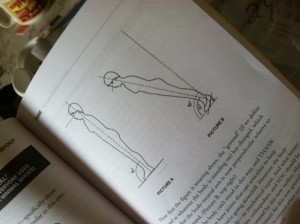This article from 2015 was lightly edited/updated in 2020. For more on kid-movement, read through our favorite resources on More Movement for Kids and Babies. For more on feet and walking, including kid-feet, read through Our Favorite Feet, Footwear, and Walking Resources.
I’m going to say it straight: I don’t like to see a child in heeled shoes. Let me be clear. I'm not only talking about high heels or those plastic high-heel costume shoes. I'm talking about school shoes and soccer shoes. Summer sandals, toddler shoes, and “healthy shoes for kids.” If you look at the kid shoes around you, you're likely to find that, like adult shoes, there's a heel on almost every pair.
 Now, I love math and I find it constantly useful. Kid shoes make me think about trigonometry, especially when I see the same 1" heel on both a kid's size 8.5 shoe and a woman's size 7 (the shorter the foot, the greater the impact that 1" has on alignment). I expanded on this in my book Whole Body Barefoot and I’m putting that section below because I think it's important information.
Now, I love math and I find it constantly useful. Kid shoes make me think about trigonometry, especially when I see the same 1" heel on both a kid's size 8.5 shoe and a woman's size 7 (the shorter the foot, the greater the impact that 1" has on alignment). I expanded on this in my book Whole Body Barefoot and I’m putting that section below because I think it's important information.
KIDS AND HEELED SHOES
Recalling Picture B on page 15 [added below for your reference], there are three measures that affect how much a heel distorts a body from neutral: the height of the heel, the length of the foot, and the height of the body.
The shorter the foot wearing a heeled shoe, the greater the angle upon which the foot is set. When it comes to putting kids in heeled shoes, it bears emphasizing:
- The higher the heel, the more forward the body is projected.
- The shorter the foot, the more forward the body is projected.
- The taller the body, the more forward the body is projected.
Kids are short, but they also have short feet, which is why it drives me crazy to see a child’s shoe with a heel the same height as their parents’. The short foot of a child “magnifies” a heel’s effect—even a heel of seemingly inconsequential height. Which means that, in the case of these shoes (a woman’s size 7 and a child’s size 8.5), the angle between the standing surface and the foot would be much greater in the child than in the adult.
It also means that the necessary compensation to get the body back “upright” is relatively greater for the child than the adult. Want to experience the math for yourself? Go to a free-standing bookshelf and put this book under either the right or left side to see how far the bookshelf tips. (For extra fun, look how the books shift and imagine how the loads to each of the “book cells” change in this arrangement.) Then put this book under the back of the bookshelf and again, note the total distance traveled by the unit...and the books.
Barring medical conditions or the occasional dress up, heeled shoes have no place in a child’s wardrobe. Children’s shoes are not mini versions of adult fashion; they’re maxi versions. They amplify the deleterious effects of traditional footwear. For this reason (and for many others), I buy only minimal shoes for my kids.
* * *
When you first start looking for more minimal footwear, it feels impossible to find shoes without heels (or elevated toes, or pointy toe-boxes that squish the toes together, or don't fully attach, like a slide-on or flip-flop).
Fortunately, companies that make "minimal shoes" (to various degrees) are sprouting up all of the time. Look through our minimal shoe list for brands and how to evaluate minimal features. You can also find a list of kid-specific footwear info in our guide to "back to school minimal shoe shopping."


